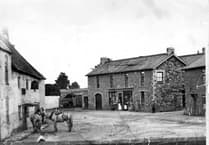Well, last year, I thought it was the Year of the Slug. Happily, this year during April, it seemed to be the Year of the Primrose! They have spread wonderfully across the lawn and through the vegetable garden, also along local roadside banks and the churchyard. A joy to behold.
We had a cold and dry March, which we all hope will mean fewer slugs. However, a few small slugs still seem to find their way indoors and lurk under seed trays, ready to nip off your precious few seedlings that did germinate. New seed is usually more successful, but I still hoped some of last year’s seed would be viable, even though I didn’t have room to keep it in the fridge year-round as recommended.
So, some variable results—and as for new seed purchased, wouldn’t you know it, fewer seeds per packet but more expensive.
Sadly, my Wollemi Pine seedling collapsed. It was so slow-growing, I probably gave it too much attention. And it had even just put out millimetre-long true leaves! I suppose if it was going to live for a hundred years, it was entitled to a slow start. Disappointed, but will try again.
No frogspawn either, but I saw my first butterflies on March 31 when it was 18 degrees outside.
All I saw was a flash of red as a pair, moving fast and circling each other, disappeared over the roof. Maybe Peacocks or Red Admirals. A week later, in the lovely warm period, I saw a Brimstone, Speckled Wood and Orange Tip butterfly all within a few minutes. I also stepped over the oil beetle as he trundled through the celandines in the orchard—almost the same place, same time as last year! The Pulmonaria (Lungwort) was host to the rather comical-looking bee fly, with its arrow-shaped outline of fat furry body and long pointy proboscis, along with bumble and honey bees.
Walking the dog at this time of year, I was often to hear the alarm calls of birds guarding their territories—a Great Tit darting up and down the stream in agitation, and blackbirds startled out of the hedgerow. The ravens were calling with their peculiar abrupt gulping sound, and a pair of crows called loudly as they raced across the sky. The cock pheasant patrolled the orchard in nonchalant manner, the hen presumably on a nest somewhere.
My husband and I were now competing (humorously) for space in the garden room as he prepared equipment, hopefully to take off some honey in May. In the glorious early sunshine, bee colonies expanded fast and nectar from spring blossom was abundant. However, my tomato seedlings were ferried daily between greenhouse and garden room as temperatures plunged from 23 degrees to 1 degree at night. Despite the church-size candle’s valiant effort to provide some heat, the tomato leaves turned purplish in protest at such treatment, and I had to mollycoddle them back to health in warmer climes.
H.W




